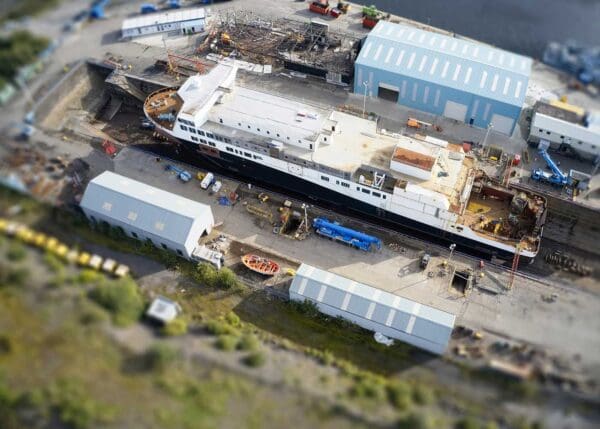01. Shipyard History
History
The 650-acre Puget Sound Naval Shipyard is located in Bremerton, Washington, along the Puget Sound. Established in 1891, the shipyard is still in operation today as the Puget Sound Naval Shipyard & Intermediate Maintenance Facility.
Puget Sound Naval Shipyard has built, serviced, repaired, overhauled, modernized, decommissioned and recycled thousands of ships and submarines through both world wars and several other conflicts including the Korean War. The peak of employment was in 1945 when the Puget Sound Naval Shipyard had a workforce of 32,500 and the navy yard was open 24 hours a day. In 1990, the U.S. Navy authorized a program to recycle nuclear-powered ships at Puget Sound Naval Shipyard.
Today, Puget Sound Naval Shipyard is on the National Register of Historic Places as a National Historic Landmark District. The shipyard is responsible for overhaul, maintenance, modernization, repair, docking and decommissioning of ships and submarines and technical and logistics support.
Puget Sound Naval Shipyard History at a Glance
- Other Names: Puget Sound Naval Shipyard and Intermediate Maintenance Facility, PSNS&IMF, Puget Sound Naval Shipyard Complex, PSNS, Navy Yard Puget Sound
- Location: Located in Bremerton, Washington, along the Sinclair Inlet on Puget Sound, about 15 miles west of Seattle
- Owner(s): Federal government, City of Bremerton
- Years of Operation: 1891 – Present
- Wartime Operations: World War I (WWI), World War II (WWII) and the Korean War
- Number of Employees: 32,500 workers in 1945
- Size of Shipyard: 650 acres
- Noteworthy Ships: USS Kitty Hawk, USS Constellation, USS Enterprise
- Noteworthy Personnel: Lt. Ambrose Wyckoff, Captain William Turnbull Burwell
- Types of Ships Built/Serviced: Subchasers, submarines, minesweepers, guided-missile frigates, aircraft carriers, battleships, destroyers
Many workers at Puget Sound Naval Shipyard were potentially exposed to asbestos. Workers’ loved ones may have also experienced secondhand exposure. As a result, many people developed asbestos-related diseases, such as asbestosis, asbestos lung cancer and pleural and peritoneal mesothelioma. People who developed an asbestos-related disease may be eligible for compensation.
Notable Ships Built and Repaired
For more than a century, Puget Sound Naval Shipyard has built, overhauled, repaired and provided maintenance to U.S. Naval ships. Some notable ships to have passed through for overhauls include the aircraft carriers, USS Constellation and USS Kitty Hawk.
USS Constellation
The aircraft carrier, USS Constellation, was laid down in the Brooklyn Navy Yard in 1957. She had six combat deployments to Vietnam between 1964 and 1972. She spent time in Puget Sound Naval Shipyard for two major overhauls in 1974 and 1983.
Proclaimed “America’s Flagship” by President Ronald W. Reagan in 1981, the USS Constellation had several more deployments to the Arabian Gulf, the Indian Ocean, Japan and Korea. Her final deployment was in support of Operation Enduring Freedom after the 9/11 attack against the United States. She was decommissioned in 2003.
Asbestos was used in shipbuilding and overhauls during much of USS Constellation’s lifetime. Workers and crewmembers who worked aboard her are at risk of developing mesothelioma.
USS Kitty Hawk
USS Kitty Hawk was an aircraft carrier laid down by New York Shipbuilding Corp. in 1956. Her first major wartime effort was in 1964 with the Vietnam War. In 1965, the carrier received a $14 million overhaul at Puget Sound Naval Shipyard. In 1965, the Walt Disney motion picture Lt. Robin Crusoe, USN, was filmed on board the ship. She returned to Vietnam for several more deployments between 1965 and 1972.
USS Kitty Hawk was once again back at Puget Sound Naval Shipyard for an overhaul in 1982. In 1992, USS Kitty Hawk was part of Joint Task Force Somalia for Operation Restore Hope, a humanitarian relief operation for the people of Somalia. In 1994, a portion of the movie, Clear and Present Danger, was filmed on the ship. In September 2001, she joined Operation Enduring Freedom after the 9/11 attacks, and in 2003, Operation Iraqi Freedom. USS Kitty Hawk was decommissioned in 2009 at the Puget Sound Naval Shipyard.
USS Kitty Hawk was a very active and famous ship. With asbestos being used in shipbuilding and overhauls from the time she was built to the time of her last overhaul in 1982, this put anyone on board at risk of developing asbestos-related diseases.
02. Shipyard Asbestos Use
Asbestos Use at Puget Sound Naval Shipyard
Asbestos is highly heat resistant and durable. Thus, it was used in many aspects of ship construction. Shipbuilders used asbestos to prevent fires and control the amount of heat released by heavy equipment.
Puget Sound Naval Shipyard has been very active since 1891. During many of these decades, asbestos use was very common. At Puget Sound Naval Shipyard, asbestos was used as insulation in walls, boilers, incinerators and around pipes. As a result, workers came in contact with many products that put them at risk of asbestos-related diseases.
Asbestos Exposure at Puget Sound Naval Shipyard
Members of the U.S. military and civilians provided labor in shipyards and on ships. Asbestos was used in most shipyards, including Puget Sound Naval Shipyard, and aboard most vessels from the 1930s to the 1980s. This likely exposure puts Navy veterans at an increased risk of malignant mesothelioma cancer.
People who constructed or maintained subchasers, submarines, minesweepers, guided-missile frigates, aircraft carriers, battleships, destroyers and other ships during this time were likely exposed to asbestos. These people often worked in space-constrained and poorly ventilated areas, which possibly allowed more asbestos fibers to remain in the work areas. For example, steamfitters faced asbestos exposure.
Starting in the 1980s, most newly manufactured products did not contain asbestos. However, anyone who continued working in the shipping industry risked exposure to asbestos. That exposure could occur through legacy asbestos materials. Many shipyard duties, including insulating the ship, maintaining boilers and installing pipes, exposed people to asbestos.
03. Asbestos Lawsuits
Asbestos Lawsuits and Settlements
People who worked on ships at Puget Sound Naval Shipyard are at risk of developing asbestos cancer or other related diseases. After a diagnosis, these shipyard workers have compensation options.
Victims can be compensated by the companies that exposed them to asbestos. Their compensation options depend on the status of that company. Victims can work with a mesothelioma lawyer to secure payment from a lawsuit, settlement, trust fund and/or VA claim (or a combination of these types of claims).
Holding Asbestos Companies Responsible
Some asbestos product manufacturers remain in business today. This means these companies have not filed for bankruptcy and victims can file lawsuits against the company. Lawsuits may result in compensation through verdicts or settlements.
For example, people were wrongfully exposed to asbestos at Puget Sound Naval Shipyard because of valves and pumps supplied from Weir Valves & Controls USA, Inc.
Schneider Electric USA, Inc. is another viable company that produced asbestos-containing materials. They produced electrical application products that have been supplied for shipbuilding for over 90 years.
Victims have filed successful lawsuits against these companies.
04. Filing Asbestos Claims
Asbestos Company Trusts
Since the 2000s, more than 100 companies have filed bankruptcy after exposing people to asbestos and the resultant lawsuits. Many of these asbestos companies had to create trust funds to compensate current and future victims of asbestos-related diseases.
Asbestos was a common occupational hazard for shipyard workers. If a shipyard worker developed an asbestos-related disease, that person can file an asbestos claim with that manufacturer’s trust.
Asbestos Company Trust Funds and Eligible Years of Employment
The following companies provided asbestos products to Puget Sound Naval Shipyard. After facing many asbestos lawsuits and exposing innocent people to asbestos, these companies filed for bankruptcy and created trusts to pay victims. If an individual worked at Puget Sound Naval Shipyard and developed a disease such as mesothelioma, they may be able to file a claim against these companies’ trusts.
| Asbestos Trust Funds & Eligible Years of Employment | ||
|---|---|---|
| Asbestos Company Name | Eligibility Start Date | Eligibility End Date |
| AC&S Inc. | 6/10/1972 | 12/31/1982 |
| Babcock & Wilcox | 1/1/1902 | 12/31/1982 |
| Combustion Engineering | 12/31/1943 | 12/31/1982 |
| Fibreboard | 1/1/1941 | 12/31/1982 |
| Flexitallic | 1/1/1941 | 12/31/1982 |
| Halliburton | 9/29/1938 | 12/31/1982 |
| Keene Corp. | 1/1/1940 | 12/31/1982 |
| Narco | 1/1/1966 | 3/31/1973 |
| Owens Corning | 1/1/1941 | 12/31/1982 |
| Pittsburgh Corning | 1/1/1964 | 12/31/1982 |
| Plant Insulation | 1/1/1948 | 12/31/1982 |
| Turner and Newall | 1/1/1950 | 12/31/1982 |




